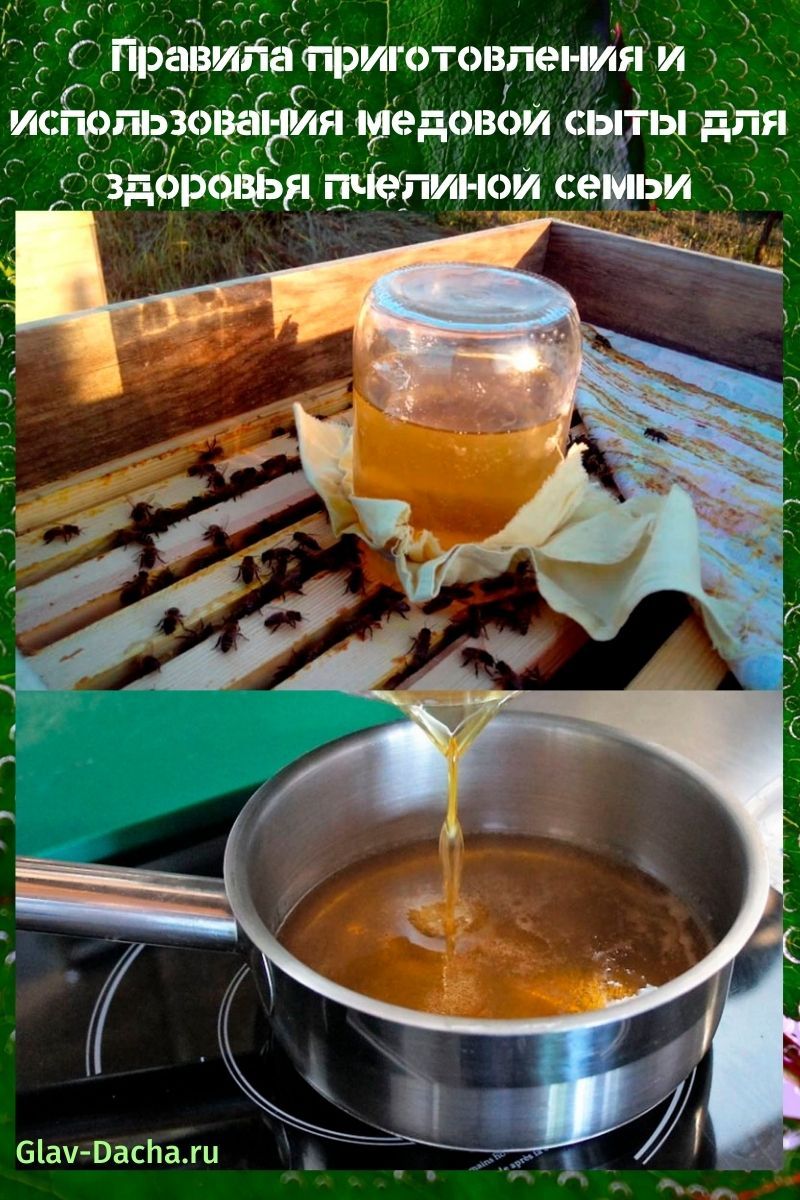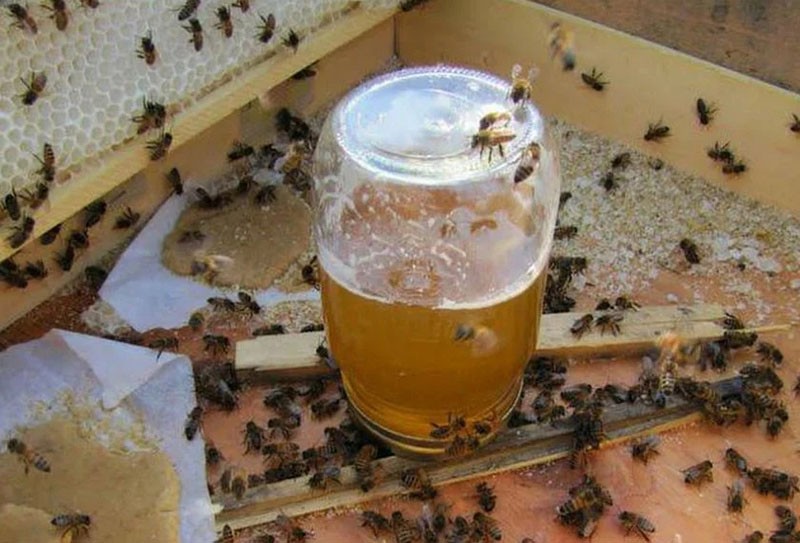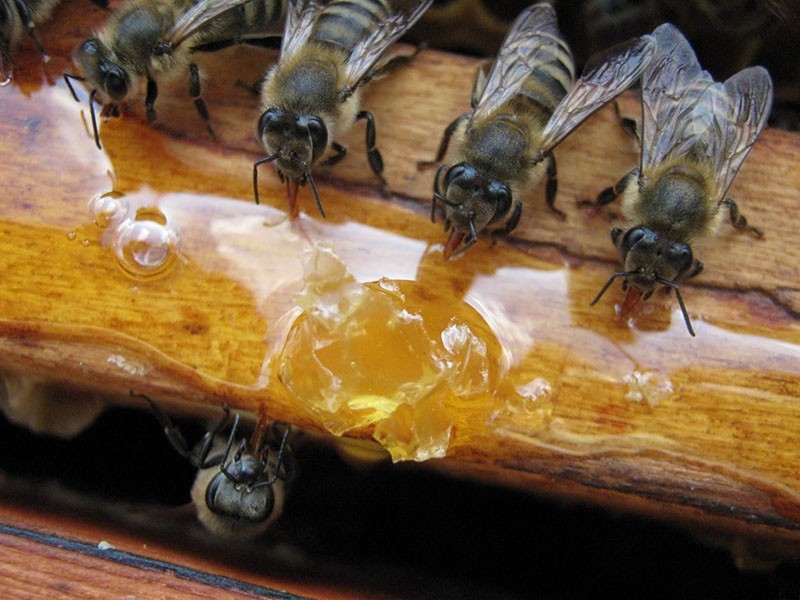Rules for the preparation and use of honey fed for the health of the bee family
 Honey fed is one of the most popular bee feeds, which is in demand among many beekeepers. Of all types of bee feeding, it is the most useful and natural. Unlike sugar syrup, honey feed, which is diluted honey, contains a huge amount of vitamins, micro- and macroelements and other biologically active substances. Such additional nutrition helps to strengthen the apiary and stimulate the queen bee to brood.
Honey fed is one of the most popular bee feeds, which is in demand among many beekeepers. Of all types of bee feeding, it is the most useful and natural. Unlike sugar syrup, honey feed, which is diluted honey, contains a huge amount of vitamins, micro- and macroelements and other biologically active substances. Such additional nutrition helps to strengthen the apiary and stimulate the queen bee to brood.
Honey full - the main features

Honey full is called natural honey diluted with boiled water to various concentrations. This is a natural top dressing, the composition of which is as close as possible to natural nectar. It is given to bees in the spring months, as well as at the beginning of summer in the absence of flowering honey plants... To prepare top dressing, you can use not only fresh, but also last year's honey, which makes it quite affordable.
The results of feeding bees with honey fed:
- an increase in the number of bee families;
- strengthening the immune system and increasing disease resistance in insects;
- stimulation of egg-laying in queen bees;
- helping the population in early departures for collecting nectar.
Due to the natural composition of honey feeding, bees willingly consume it, getting all the necessary supply of vitamins, micro- and macroelements in an optimal ratio. They are less likely to get sick and tolerate negative weather conditions well.
In addition, the product deposited in the honeycomb by the bees is natural, and not candied, as when feeding with sugar syrup.
Types of honey fed depending on concentration
 Honey fed recipes include only two ingredients - natural honey and warm water. The concentration of these ingredients depends on the season. For example, in the spring season, bees need a minimum of moisture, so feeding is prepared in a ratio of 1 part water to 3 parts honey.
Honey fed recipes include only two ingredients - natural honey and warm water. The concentration of these ingredients depends on the season. For example, in the spring season, bees need a minimum of moisture, so feeding is prepared in a ratio of 1 part water to 3 parts honey.
Honey satiety varies depending on concentration:
- Medium concentration - intended for incentive feeding, most often used for bee colonies weakened after wintering. Top dressing contains the necessary proteins and carbohydrates that allow insects to grow stronger and stimulate development and reproduction. For well-fed honey and water are used in equal proportions.
- Dense concentration - such a well-fed is used by beekeepers to stimulate bee colonies to replenish food supplies. Most often it is given to insects in early spring, after the initial inspection of the hives. For its preparation, honey and water are taken in a 4: 1 ratio.
- Liquid concentration - made from honey and water in a 1: 2 ratio. This top dressing is intended for spraying on two colonies to combine them into one family.
Liquid honey feed is more suitable for feeding bees in early summer, before honey plants bloom. Dense Sated is used in the fall.
Top dressing recipes
 For the preparation of honey nourishment, you can use both last year's candied honey and a liquid beekeeping product.The most important rule is that it must be natural and not contain any additives or impurities.
For the preparation of honey nourishment, you can use both last year's candied honey and a liquid beekeeping product.The most important rule is that it must be natural and not contain any additives or impurities.
How to make honey feed for feeding bees from liquid honey:
- Pour 220 ml of pure, best filtered water into a saucepan and bring to a boil.
- Remove the water from the stove and let it cool down to about 40 ° C.
- Add 130-150 g of natural liquid honey to warm water and mix well until completely dissolved.
- After the honey solution has cooled to room temperature, it can be used to feed the bees.
For the preparation of honey fed, you can also use last year's candied honey. To do this, dissolve 110-130 g of the candied product in a water bath, being careful not to overheat.
Pour 220 ml of water into a saucepan and boil, then let it cool to 40 ° C. Stir in melted beekeeping product until all grains are dissolved. When the solution has cooled to room temperature, it can be used to feed bee colonies.
In the case of using gurt honey with wax residues to prepare top dressing, it is advisable to increase its volume by about ¼ part. When the beekeeping product is completely dissolved in water, the wax particles must be squeezed out by hand or filtered.
 Very often, beekeepers add various additives to honey feeding that attract bees. It can be ground pepper and cloves, pieces of bacon, dried ants and roots of aromatic herbs.
Very often, beekeepers add various additives to honey feeding that attract bees. It can be ground pepper and cloves, pieces of bacon, dried ants and roots of aromatic herbs.
Application of honey fed
 The instructions for feeding honey-fed bees recommend using this natural remedy both in early spring and in autumn. For each feeding, you need to prepare a new portion of the full, since in warm temperatures it quickly sours.
The instructions for feeding honey-fed bees recommend using this natural remedy both in early spring and in autumn. For each feeding, you need to prepare a new portion of the full, since in warm temperatures it quickly sours.
The first feeding with honey fed is carried out in early spring. At the beginning of the spring season, after the end of the flyby, the beekeeper can reliably determine how much feed is left in the bee colony.
If all the winter food has been eaten, or there is extremely little of it left, and there are no completely filled frames, you can feed the bee family with honey fed.
Rules for feeding fed honey:
- For one bee colony, up to 1.2-1.3 liters of honey feeding will be required. It is advisable to prepare 1-2 liters additionally in case of frosty or rainy weather.
- Feed in a volume of 4-5 liters can be divided into several portions and feed the bee colony several times with a pause of 2-3 days.
- Feeding is best done in the evening, pouring honey feed into ceiling troughs or placing on honeycomb frames inside the hive. In the evening, there is a minimal risk that other bees will attack the sweet feeding.
- Plastic bottles with slotted holes or canned drinkers can be used as feeders.
- Feeding honey bees in spring is carried out no later than 35 days before the period of swarming of bee colonies. This time can vary significantly depending on the climatic characteristics of a particular region.
- Summer additional feeding is required for bees only if they cannot fly out of the hive to collect nectar due to cold weather or prolonged torrential rains.
- Summer feeding with honey fed is carried out for bee colonies whose hives are located in regions with a significant gap between the honey harvest.
- Feeding bees with honey in the fall is recommended in case of complete withdrawal honey from hives or in the form of additional winter nutritional reserves.
 Feeding honey-fed bees is an effective and safe way to strengthen insect immunity and restore their strength after wintering. Natural feeding stimulates queen bees to lay eggs, contributing to an increase in the number of bee colony and active collection of nectar.
Feeding honey-fed bees is an effective and safe way to strengthen insect immunity and restore their strength after wintering. Natural feeding stimulates queen bees to lay eggs, contributing to an increase in the number of bee colony and active collection of nectar.